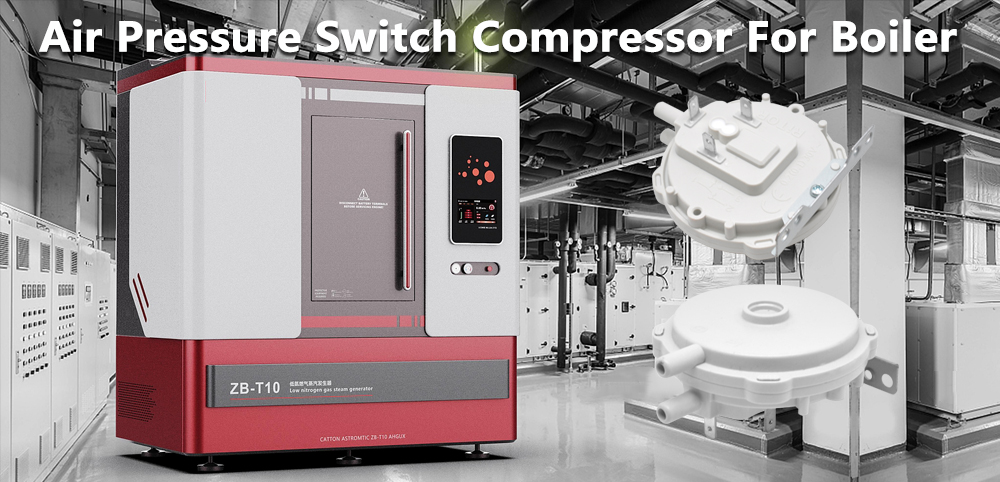Introduction of air pressure switch compressor
When air pressure switches compressors and boilers, different units are usually involved. Common units are pascal (Pa) and bar (bar) for pressure, and kilopascal (kPa) is also often used. Different pressure ranges may be used when describing air pressure switches, compressors, and boilers. An air pressure switch is a device used to monitor gas or liquid pressure and switch on and off at a set pressure threshold. When describing an air pressure switch, it may refer to the pressure at which it triggers or cuts off. For example, 30Pa and 60Pa may be the pressure thresholds that trigger or shut off the switch. This means that when the pressure reaches or exceeds 30Pa, the switch may open, and when the pressure reaches or drops to 60Pa, the switch may close.
Compressors are often used to increase the pressure of gases. Here, it may refer to the compressor’s operating range or rated pressure. If it is in the range of 30Pa to 60Pa, it may mean that the compressor can compress the gas to 30Pa and provide an output of up to 60Pa when needed. Boilers are usually associated with hot water or steam, and in this context, pressure may be described in units of bar. For example, the operating pressure of a boiler may range from 30 bar to 60 bar. This represents the range of pressures the boiler can withstand and produce when operating.

How air pressure switch compressors for boilers work
Air pressure switches contain a sensing element, usually a spring and piston combination. This element is sensitive to gas pressure changes. The compressor draws air into the cylinder or chamber of the compressor through a piston or rotating mechanism. During inhalation, the pressure of the gas decreases and its volume increases.
Air pressure switches usually have an adjustment device that allows the user to set the trigger and cutoff pressure values of the switch. In this way, users can adjust it according to the needs of the system. The compressor compresses the inhaled gas by reducing the volume of the chamber or cylinder. During this process, the pressure of the gas increases.
The air pressure switch is connected to the electrical control system of the boiler system. When the sensing element is acted upon by gas pressure, it triggers a change in the switch state. When the gas pressure rises to the set trigger pressure value, the sensing element is pushed, causing the switch to switch to the closed state. On the contrary, when the gas pressure drops below the set cut-off pressure value, the sensing element will rebound, causing the switch to switch to the off state.
A change in the state of the air pressure switch triggers an electrical signal that controls other components in the boiler system, such as a circulation pump or burner, to maintain the normal operation of the system. The compressed gas is discharged into the system through the compressor. At this time, the pressure of the gas is higher.
In a boiler system, the compressor may be used to provide the required gas mixture or to perform other functions in other parts of the system. The air pressure switch is responsible for monitoring and controlling the gas pressure in the system to ensure operation within a safe range. The two work together to help keep your boiler system running properly.
How an Air Pressure Switch Compressor Improves Boiler Performance
Proper application of air pressure switch compressors in boiler systems can improve boiler performance, safety, and efficiency. Proper application and maintenance of air pressure switch compressors is one of the keys to ensuring efficient and safe operation of the boiler system. Its reasonable setting and accurate control can help improve boiler performance, reduce energy consumption, extend equipment life, and ensure system stability and safety.
Table of Contents
Toggle1. Security improvement
Air pressure switch compressors are used to monitor and control the gas pressure in the boiler system to ensure operation within a safe range. By accurately setting the trigger and cut-off pressure values of the switch, the boiler can be prevented from malfunctioning or safety issues due to abnormal pressure.
2. Precise control
The design of the air pressure switch compressor allows the user to adjust the trigger and cut-off pressure values to achieve precise control of the boiler system. This helps keep the boiler operating within design parameters and improves system controllability.
3. Energy efficiency optimization
Air pressure switching compressors can help optimize energy efficiency by ensuring your boiler system is operating within the proper pressure range. Pressure that is too high or too low can result in reduced boiler performance or wasted energy, while correct pressure control helps maintain optimal energy efficiency.
4. Extend equipment life
Proper use of air pressure switch compressors can help reduce overload and overpressure conditions in the system, thereby extending the life of the boiler and related equipment. Accurate pressure control helps reduce wear and damage to equipment.
5. Prevent drying and corrosion
Boilers that are over- or under-pressured can create problems such as pipe corrosion and scale formation. By properly setting up and maintaining your air pressure switch compressor, you can avoid these problems and improve your system’s reliability.
6. Cope with load changes
The flexible adjustment performance of the air pressure switch compressor allows it to adapt to changes in load. When the load on the boiler system changes, by adjusting the switch settings, you can ensure that the boiler can still operate efficiently under different load conditions. Some air pressure switch compressors have an alarm function that can trigger an alarm or shut down when the pressure is abnormal. This helps to detect and solve potential problems in a timely manner, improving the reliability and safety of the boiler system.
Application scenarios of boilers in air pressure switch compressors
Air pressure switch compressors have several key application scenarios in boiler systems, mainly involving monitoring and controlling the gas pressure inside the boiler. Air pressure switch compressors are often used to control the start and stop of boiler systems. When the gas pressure in the boiler system reaches the set starting pressure, the air pressure switch compressor is triggered to start the boiler. On the contrary, when the gas pressure inside the boiler drops below the set stop pressure, the air pressure switch compressor cuts off the power supply and stops the boiler.
The air pressure switch compressor monitors the pressure of the gas inside the boiler in real-time. It can detect the presence of abnormal pressure, such as too-high or too-low-pressure conditions. In this case, the switch may trigger an alarm or take appropriate safety measures to avoid potential malfunctions or dangers. An important function of the air pressure switch compressor is to protect the boiler system from overpressure and overloading. By setting appropriate trigger and cut-off pressure values, you can ensure that the boiler operates within a safe pressure range and avoid damage or dangerous situations caused by overpressure or overload.
The flexible regulation capabilities of the air pressure switch compressor allow the boiler system to adapt to changes in load. When the load changes, the switch settings can be adjusted to ensure that the boiler can still operate efficiently under different load conditions. Some boiler systems need to maintain a certain positive pressure to prevent vacuum conditions. Air pressure switch compressors can be used to monitor and maintain the positive pressure status of the system to ensure gas flow and prevent impurities in the air from entering the boiler.
Some air pressure switch compressors have an alarm function. When the gas pressure in the boiler system exceeds the normal range, the switch can trigger an alarm to alert the operator or automatically take measures to avoid potential problems. The air pressure switch compressor is an important safety control component in the boiler system. Its correct setting and maintenance are crucial to ensuring the stable and efficient operation of the boiler.
Features of Air Pressure Switch Compressor
Air pressure switches compressors play a key role in compressor systems for monitoring and controlling gas pressure. The air pressure switch can be set to trigger when the gas pressure reaches a certain value or to cut off when the gas pressure drops to another set value. This enables it to control the start and stop of the compressor within a specific pressure range.
Most air pressure switch compressors have adjustable parameters that allow the user to adjust the trigger and cut-off pressure thresholds based on the needs of the specific application. This adjustability makes the air pressure switch suitable for different types of compressors and applications. Air pressure switches are usually very sensitive and can sense slight changes in gas pressure. This characteristic is very important for accurately monitoring and controlling gas pressure to ensure system stability and safety.
Air pressure switches maintain stable performance under varying environmental conditions. This includes stable operation under changing temperature and humidity conditions, as well as within different pressure ranges. The air pressure switch needs to have sufficient pressure resistance to cope with the high-pressure conditions that may occur in the compressor system. They are usually designed to withstand a range of gas pressures without damage.
The pressure switches compressors are an important part of the compressor system, so their reliability is critical. High-quality air pressure switches typically feature durable materials and reliable internal construction to ensure long-term, stable operation. Because compressors may operate in a variety of environmental conditions, including high and low temperatures, and humid or dry environments, air pressure switches often need to have a certain degree of environmental adaptability.
